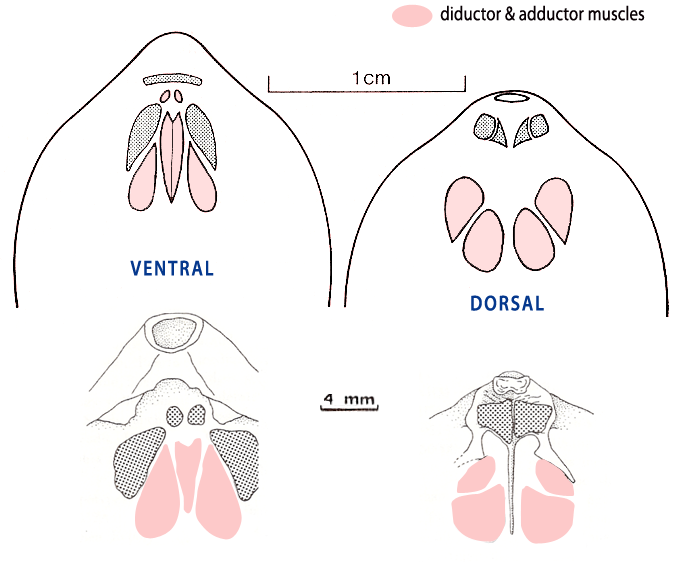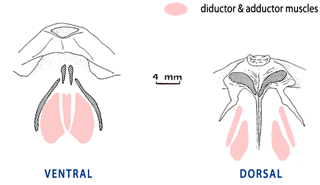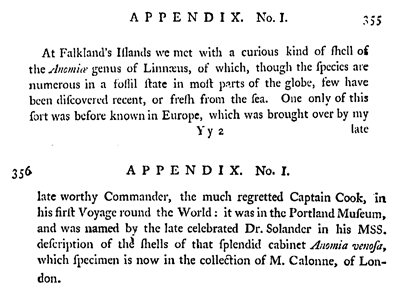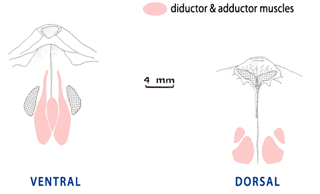|
Magellania flavescens (Lamarck, 1819)
Type locality: Sea of India to Java (Lamarck) -
probably Port Jackson (SE Australia)
Depth range: 11 - 182 m
Terebratula flavescens Lamarck, 1819
Terebratula dentata Lamarck, 1819
Terebratula incurva Defrance, 1828
Terebratula australis Quoy & Gaimard, 1835
Terebratula recurva Quoy & Gaimard, 1835
Terebratula plombea Deshayes, 1836
Magellania euthrya Philippi, 1844
Terebratula spadae Aradas, 1846
Waldheimia australis King, 1850
Terebratula glabra Leach, 1852
Waldheimia cranium Gray, 1853
Waldheimia flavescans Davidson, 1853
Frenula jeffreysi (ex parte) Dall, 1871
Terebratula incurva Davidson, 1886
? Terebratula mayi Blochmann, 1914
Magellania iredalei Allan, 1939
Magellania cranium var. novangliae Dall, 1920
Diagnose in preparation -
Should be added:
Muscle disposition: see Fig. in front - large blocklike dorsal pedicle adjustor muscles scars that extend to the middle of the hinge plate.
|

Disposition of the pedicle and pedicles muscles - sagittal section
(from Richardson, 1979)

Muscle attachment (from Richardson, 1979; and
from Foster, 1974 - with absence of separate posterior accessory diductor muscles base, the pair of ventral adductor muscle bases in a single unit)
|
|
Magellania venosa (Solander, 1786)
Type locality: “the country unkown” (Solander, 1786); “Falkland’s Islands” (Dixon, 1789).
Depth range: 2 - 3510 m
Anomia venosa Solander, 1786
Anomia venosa Solander: Dixon (1789)
Terebratula dilata Lamarck, , 1819
Terebratula malvinae d'Orbigny, 1847
Terebratula fontanea d'Orbigny, 1847
Terebratula pulvinata Gould, 1850
Waldheimia venosa Davidson, 1861
Magasella laevis Dall, 1870
Magellania venosa Fischer & Öhlert, 1892
Magellania (Neothyris) venosa Dall, 1920
Waldheimiathyris americana Elliot, 1951
Aerothyris? venosa Levy, 1961
Magellania? venosa Cooper, 1981
Diagnose in preparation -
Should be added:
Muscle disposition: see Fig. in front >
Original description in Solander (1786):

In front: Description of Dixon (1789) p. 355-356 in the English version >>
[and p. 281 in the French version] |

Muscle attachment ( from Foster, 1974 - with absence of separate posterior accessory diductor muscles base, the pair of ventral adductor muscle bases in a single unit)

|
|
Magellania joubini Blochmann, 1906
Type locality: “Winter-station der Gaußexpedition in 385 m Tiefe” [66°20’S, 89°38’E].
Depth range: 80 - 1894 m
Magellania sulcata Smith, 1907
Campages joubini Hedley, 1911
Aerothyris joubini Allan, 1939
Aerothyris joubini Zezina, 1976
Aerothyris joubini Zezina, 1980
Diagnose in preparation -
|
|
|
Magellania fragilis Smith, 1907
Type locality: : “Agassiz island, 300 fathoms, off ice barrier” [549 m].
Depth range: 75 - 1352 m
Stetothyris antarctica Thomson, 1918
Aerothyris fragilis Allan, 1939
Victorithyris? antarctica Allan, 1940
Diagnose in preparation -
Should be added:
Muscle disposition: see Fig. in front - dorsal pedicle adjustor muscle scars meet in the middle of the hinge plate; absence of accessory diductor muscle scars.
|

Muscle attachment (from Foster, 1974 -
with absence of separate posterior accessory diductor muscles base, the pair of ventral adductor muscle bases in a single unit)
|







